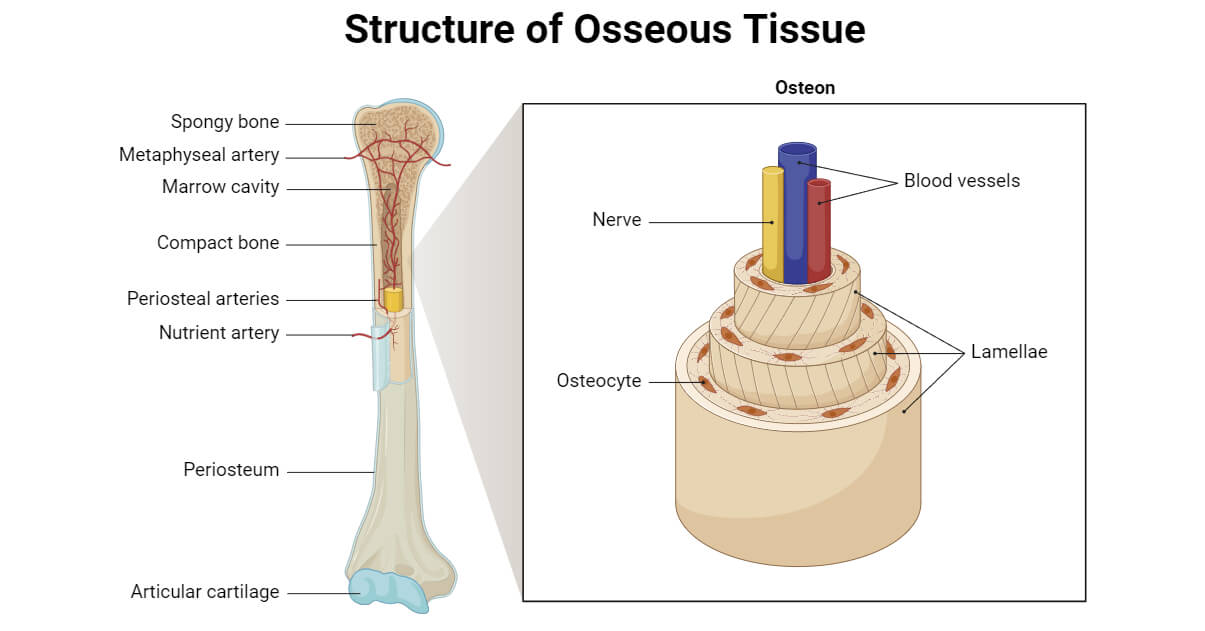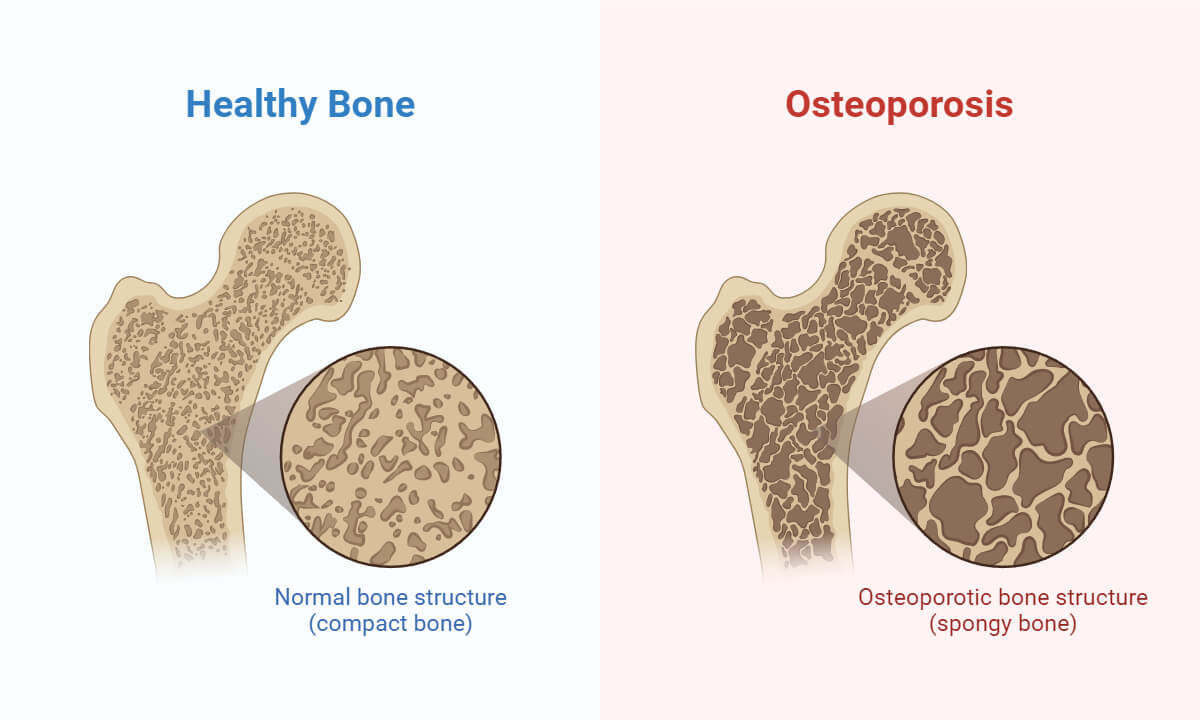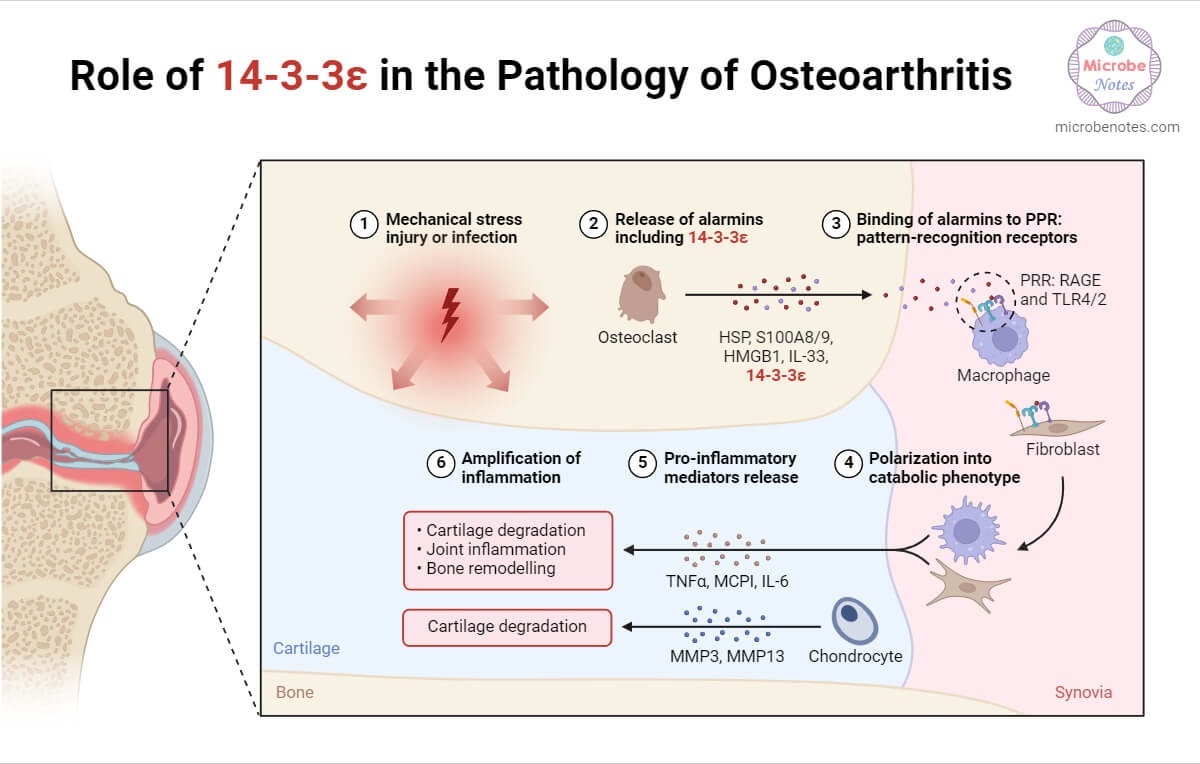Bone is often considered a rigid and lifeless material. However, they are active parts of the skeletal system and have numerous vital functions in the living system.
Biologically, bone is a dynamic connective tissue maintained by the bone cells that make up the skeletal system. It provides the structural framework and support for the body, allows body movement, and protects internal organs. It also contributes to maintaining the balance of minerals in our body.
Bone consists of an extracellular matrix and bone cells. This combination of matrix and cells makes bone an active part of our overall physiological balance and bodily functions.

Bone cells are the cellular components of bone tissue. Bone cells play an important role in maintaining the bone tissue, which, in turn, supports the overall structure, movement, and mineral balance within the body. Found throughout the skeletal system, bone cells contribute to the dynamic and living nature of bones.
Interesting Science Videos
Types of Bone Cells
There are three main types of bone cells: osteoblasts, osteocytes, and osteoclasts.
Osteoblasts
- Osteoblasts are bone-forming cells that constitute 4-6% of all bone cells. They are located in the growing areas of bone, such as the endosteum and periosteum. Osteoblasts do not divide.
- Osteoblasts are derived from precursor cells called osteoprogenitor or osteogenic cells that originate from pluripotent mesenchymal stem cells (MSCs) of the bone marrow.
- The main function of osteoblasts is to synthesize the components of the extracellular matrix of bone, including structural macromolecules like type I collagen, various proteoglycans, and proteins. Osteoblasts are also involved in bone mineralization.
- After forming the bone matrix, some osteoblasts get trapped in the bone, transforming into osteocytes, while others become the bone lining cells that cover bone surfaces. The remaining osteoblasts undergo programmed cell death known as apoptosis.
- Osteoblasts form the bone matrix in two steps: first, by releasing substances like collagen proteins and proteoglycan to form the initial organic matrix, and second, by mineralizing the matrix.
Osteoclasts
- Osteoclasts are large, multinucleated bone-resorbing cells that break down old or damaged bone tissue.
- Osteoclasts secrete enzymes that dissolve the matrix and organic components of bone. This resorption process is important for bone remodeling, repair, and maintaining mineral balance.
- Osteoclasts originate from white blood cells of the hematopoietic stem cell lineage and are found on the surface of bone tissue.
- Osteoclasts undergo a process of recruitment, proliferation, differentiation, and fusion to carry out their bone resorption function.
Osteocytes
- Osteocytes are mature bone cells that originate from osteoblasts. They are found in small cavities called lacunae and are the most abundant cells in mature adult bone tissue comprising about 90-95% of cells in bone.
- These cells result from osteoblasts that get surrounded and trapped by the substances they secrete during bone formation.
- Osteocytes have a long lifespan of up to 25 years, and like osteoblasts, they do not divide.
- Osteocytes serve vital roles in preserving the mineral composition of bone tissue. They can deposit bone, signal other osteocytes about bone damage, and regulate the activities of osteoblasts and osteoclasts.
- Osteocytes communicate with one another through long channels in the bone matrix called canaliculi, which are also used for the transfer of nutrients and waste products.
Structure of Bone
- The bones in our body are made up of complex connective tissue comprised of bone cells and extracellular matrix.
- The matrix consists of about 60% inorganic components along with 10% water and 30% organic components. The organic component is primarily made up of collagen along with proteoglycans, and non-collagenous proteins. The inorganic component contains hydroxyapatite crystals that contribute to the hardness of bones.
- Bone consists of two main types of tissues: cortical (compact) and cancellous (trabecular or spongy) bone. Compact bone is the outer shell that surrounds the inner spongy bone.
- Compact bone contains cylindrical-shaped structures called osteons or Haversian systems that consist of concentric lamellae with nerves and blood vessels. Compact bone provides shape, strength, and protection to bones.
- Beneath the compact bone lies the spongy bone which is a porous and highly vascular internal tissue. Spongy bone supports mineral exchange and maintains skeletal strength. It also contains spaces filled with bone marrow.
- The outermost part of the bone is the tissue layer called periosteum which covers the external surface of cortical bone. On the inner side, another tissue layer called endosteum lines the inner spongy bone tissue. Both periosteum and endosteum contain osteoprogenitor cells and are involved in bone development and repair.
Structure of Osteoblast
Osteoblasts are cuboidal or columnar cells found on bone surfaces with active bone formation. These cells have morphological features common in cells that synthesize proteins, such as prominent Golgi apparatus and abundant rough endoplasmic reticulum.
Structure of Osteoclasts
Osteoclasts are large cells with multiple nuclei that are derived from the fusion of precursor cells. They have a unique ruffled border. The ruffled border is rich in enzymes that are useful for breaking down bone minerals and matrix. Osteoclasts are also characterized by a clear zone that creates an acidic microenvironment for bone resorption.
Structure of Osteocytes
Osteocytes are mature cells with a flat and almond-shaped morphology. They have a reduced Golgi complex and rough endoplasmic reticulum, along with a more condensed nuclear chromatin. Osteocytes extend long, hair-like cellular processes called dendrites into thin tubes known as canaliculi, forming a network.
Functions of the Bone Cells
- Osteoblasts contribute significantly to bone formation. These cells synthesize bone matrix to maintain the structural shape of bone. They produce collagen and other organic components. Osteoblasts also promote the deposition of minerals into the bone matrix, contributing to bone hardness.
- Osteoclasts are responsible for bone resorption. They play a vital role in the process of bone remodeling by breaking down bone tissue and releasing minerals like calcium and phosphate into the bloodstream to support the metabolic needs of the body.
- Osteocytes play a key role in maintaining bone tissue as they can sense mechanical stresses on bones. They are also involved in the exchange of nutrients and waste products through their network of canaliculi. Osteocytes also control osteoblastic and osteoclastic activities. They also act as an endocrine regulator of phosphate metabolism.
Bone Remodeling
- Bones are dynamic structures constantly changing through the process of bone remodeling. Bone remodeling is a continuous process involving both the removal of old or damaged bone and the formation of new bone material.
- This process contributes to the development of the mature structure of bone and the regulation of calcium levels in the body.
- Bone remodeling is directed by bone multicellular units (BMUs), which are assemblies of osteoblasts and osteoclasts. BMUs go through distinct phases, including activation, resorption, reversal, and formation.
- In the activation phase, osteoclasts are recruited to the targeted bone area. During resorption, these osteoclasts break down or resorb bone tissue. In the reversal stage, osteoclasts undergo apoptosis, and osteoblasts are called in. Finally, in the formation stage, osteoblasts produce a bone matrix that mineralizes, completing the remodeling cycle.
Diseases and Disorders of Bone Cells
Various genetic and environmental factors contribute to different diseases of the bone. Genetic abnormalities may result in weak bones. Nutritional deficiencies, especially in vitamin D, calcium, and phosphorus, can also lead to poorly mineralized bone. Hormonal disorders, such as growth hormone deficiencies, can also affect bone health. Some of the common bone disorders are:
Osteoporosis
Osteoporosis is an age-related bone disease characterized by low bone mass and weak bone structure, increasing the risk of fractures. This disease is linked to an imbalance between osteoblasts and osteoclasts. It is common in postmenopausal females due to lower estrogen levels. Estrogen is known to be a potent inhibitor of osteoclasts. However, it can affect males as well. There are two main forms of osteoporosis. Primary osteoporosis is the most common form that occurs due to aging while secondary osteoporosis is caused by other diseases or medications.

Rickets and osteomalacia
Rickets and osteomalacia are bone disorders caused by the deficiency of vitamin D. Vitamin D is essential for calcium absorption and its deficiency impairs the mineralization of the growing bones. Rickets is a disease affecting children that results from the defect in depositing minerals in growing bones causing skeletal deformities, including bowed legs. Osteomalacia is the adult equivalent of rickets which increases the risk of fractures. Both conditions cause bone pain and significant muscle weakness. Adequate levels of vitamin D from sunlight, diet, or supplements are essential to prevent these conditions.
Paget’s disease of the bone
Paget’s disease of the bone is characterized by abnormal bone remodeling. While it can affect any bones, it often affects the skull, pelvis, spine, and long bones. The main feature of Paget’s disease is disorganized bone remodeling, involving both excessive bone breakdown and increased bone formation. This makes the affected bones larger and weaker than normal bones. This disorganized bone structure is more likely to cause deformities or fractures. Paget’s disease can also lead to neurological complications.
Osteogenesis imperfecta (OI)
Osteogenesis imperfecta (OI), also called brittle bone disease, is a group of inherited diseases that affect the skeleton. These conditions result in bones that break easily. Different types of OI arise from different genetic defects or mutations, impacting the production of the protein called type I collagen. Most forms of OI are hereditary, although some cases may occur sporadically. People with OI usually have low bone mass, which leads to more fractures and skeletal problems.
Osteopetrosis
Osteopetrosis, also called marble bone disease, is a group of genetic disorders characterized by increased bone mass due to a decrease in osteoclast function that is involved in the resorption of bones. This disruption in the bone resorption process results in an abnormal accumulation of dense bone. Despite its density, this bone is brittle, making individuals with osteopetrosis prone to fractures. Excessive bone growth may compress nerves causing neurological issues like deafness or blindness.

References
- Bone Cells – Basic Science – Orthobullets
- Britannica, T. Editors of Encyclopaedia (2010, February 16). bone remodeling. Encyclopedia Britannica. https://www.britannica.com/science/bone-remodeling
- Cowan PT, Kahai P. Anatomy, Bones. [Updated 2023 Nov 13]. In: StatPearls [Internet]. Treasure Island (FL): StatPearls Publishing; 2023 Jan-. Available from: https://www.ncbi.nlm.nih.gov/books/NBK537199/
- El Sayed SA, Nezwek TA, Varacallo M. Physiology, Bone. [Updated 2022 Oct 19]. In: StatPearls [Internet]. Treasure Island (FL): StatPearls Publishing; 2023 Jan-. Available from: https://www.ncbi.nlm.nih.gov/books/NBK441968/
- Florencio-Silva, R., Sasso, G. R., Sasso-Cerri, E., Simões, M. J., & Cerri, P. S. (2015). Biology of Bone Tissue: Structure, Function, and Factors That Influence Bone Cells. BioMed research international, 2015, 421746. https://doi.org/10.1155/2015/421746
- Henry JP, Bordoni B. Histology, Osteoblasts. [Updated 2023 May 1]. In: StatPearls [Internet]. Treasure Island (FL): StatPearls Publishing; 2023 Jan-. Available from: https://www.ncbi.nlm.nih.gov/books/NBK557792/
- Khan IA, Bordoni B. Histology, Osteoclasts. [Updated 2023 Apr 24]. In: StatPearls [Internet]. Treasure Island (FL): StatPearls Publishing; 2023 Jan-. Available from: https://www.ncbi.nlm.nih.gov/books/NBK554489/
- Mohamed A. M. (2008). An overview of bone cells and their regulating factors of differentiation. The Malaysian journal of medical sciences : MJMS, 15(1), 4–12. https://www.ncbi.nlm.nih.gov/pmc/articles/PMC3341892/
- Nahian A, AlEssa AM. Histology, Osteocytes. [Updated 2023 May 1]. In: StatPearls [Internet]. Treasure Island (FL): StatPearls Publishing; 2023 Jan-. Available from: https://www.ncbi.nlm.nih.gov/books/NBK558990/
- Rowe P, Koller A, Sharma S. Physiology, Bone Remodeling. [Updated 2023 Mar 17]. In: StatPearls [Internet]. Treasure Island (FL): StatPearls Publishing; 2023 Jan-. Available from: https://www.ncbi.nlm.nih.gov/books/NBK499863/
- Šromová, V., Dinara S. and Pavel K. (2023). A Brief Review of Bone Cell Function and Importance. Cells 12, no. 21: 2576. https://doi.org/10.3390/cells12212576
